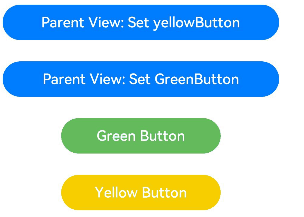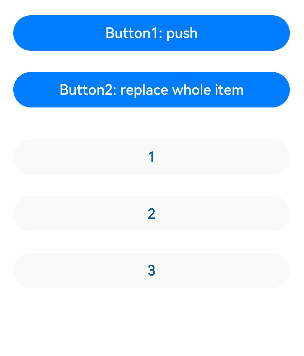子组件中被@Link装饰的变量与其父组件中对应的数据源建立双向数据绑定。
说明:
从API version 9开始,该装饰器支持在ArkTS卡片中使用。
概述
@Link装饰的变量与其父组件中的数据源共享相同的值。
限制条件
- @Link装饰器不能在@Entry装饰的自定义组件中使用。
装饰器使用规则说明
| @Link变量装饰器 | 说明 |
|---|---|
| 装饰器参数 | 无 |
| 同步类型 | 双向同步。 父组件中@State, @StorageLink和@Link 和子组件@Link可以建立双向数据同步,反之亦然。 |
| 允许装饰的变量类型 | Object、class、string、number、boolean、enum类型,以及这些类型的数组。 支持Date类型。 API11及以上支持Map、Set类型。支持类型的场景请参考 观察变化 。 API11及以上支持上述支持类型的联合类型,比如string | number, string | undefined 或者 ClassA | null,示例见 Link支持联合类型实例 。 注意 当使用undefined和null的时候,建议显式指定类型,遵循TypeScipt类型校验,比如: @Link a : string | undefined。 |
支持AkrUI框架定义的联合类型Length、ResourceStr、ResourceColor类型。 类型必须被指定,且和双向绑定状态变量的类型相同。 不支持any。 | |
| 被装饰变量的初始值 | 无,禁止本地初始化。 |
变量的传递/访问规则说明
| 传递/访问 | 说明 |
|---|---|
| 从父组件初始化和更新 | 必选。与父组件@State, @StorageLink和@Link 建立双向绑定。允许父组件中@State、@Link、@Prop、@Provide、@Consume、@ObjectLink、@StorageLink、@StorageProp、@LocalStorageLink和@LocalStorageProp装饰变量初始化子组件@Link。 从API version 9开始,@Link子组件从父组件初始化@State的语法为Comp({ aLink: this.aState })。同样Comp({aLink: $aState})也支持。 |
| 用于初始化子组件 | 允许,可用于初始化常规变量、@State、@Link、@Prop、@Provide。 |
| 是否支持组件外访问 | 私有,只能在所属组件内访问。 |
图1 初始化规则图示

观察变化和行为表现
观察变化
-
当装饰的数据类型为boolean、string、number类型时,可以同步观察到数值的变化,示例请参考 简单类型和类对象类型的@Link。
-
当装饰的数据类型为class或者Object时,可以观察到赋值和属性赋值的变化,即Object.keys(observedObject)返回的所有属性,示例请参考 简单类型和类对象类型的@Link 。
-
当装饰的对象是array时,可以观察到数组添加、删除、更新数组单元的变化,示例请参考数组类型的@Link。
-
当装饰的对象是Date时,可以观察到Date整体的赋值,同时可通过调用Date的接口
setFullYear,setMonth,setDate,setHours,setMinutes,setSeconds,setMilliseconds,setTime,setUTCFullYear,setUTCMonth,setUTCDate,setUTCHours,setUTCMinutes,setUTCSeconds,setUTCMilliseconds更新Date的属性。
@Component
struct DateComponent {@Link selectedDate: Date;build() {Column() {Button(`child increase the year by 1`).onClick(() => {this.selectedDate.setFullYear(this.selectedDate.getFullYear() + 1)})Button('child update the new date').margin(10).onClick(() => {this.selectedDate = new Date('2023-09-09')})DatePicker({start: new Date('1970-1-1'),end: new Date('2100-1-1'),selected: this.selectedDate})}}
}@Entry
@Component
struct ParentComponent {@State parentSelectedDate: Date = new Date('2021-08-08');build() {Column() {Button('parent increase the month by 1').margin(10).onClick(() => {this.parentSelectedDate.setMonth(this.parentSelectedDate.getMonth() + 1)})Button('parent update the new date').margin(10).onClick(() => {this.parentSelectedDate = new Date('2023-07-07')})DatePicker({start: new Date('1970-1-1'),end: new Date('2100-1-1'),selected: this.parentSelectedDate})DateComponent({ selectedDate:this.parentSelectedDate })}}
}
-
当装饰的变量是Map时,可以观察到Map整体的赋值,同时可通过调用Map的接口
set,clear,delete更新Map的值。 -
当装饰的变量是Set时,可以观察到Set整体的赋值,同时可通过调用Set的接口
add,clear,delete更新Set的值。
框架行为
@Link装饰的变量和其所属的自定义组件共享生命周期。
为了了解@Link变量初始化和更新机制,有必要先了解父组件和拥有@Link变量的子组件的关系,初始渲染和双向更新的流程(以父组件为@State为例)。
-
初始渲染:执行父组件的build()函数后将创建子组件的新实例。初始化过程如下:
- 必须指定父组件中的@State变量,用于初始化子组件的@Link变量。子组件的@Link变量值与其父组件的数据源变量保持同步(双向数据同步)。
- 父组件的@State状态变量包装类通过构造函数传给子组件,子组件的@Link包装类拿到父组件的@State的状态变量后,将当前@Link包装类this指针注册给父组件的@State变量。
-
@Link的数据源的更新:即父组件中状态变量更新,引起相关子组件的@Link的更新。处理步骤:
- 通过初始渲染的步骤可知,子组件@Link包装类把当前this指针注册给父组件。父组件@State变量变更后,会遍历更新所有依赖它的系统组件(elementid)和状态变量(比如@Link包装类)。
- 通知@Link包装类更新后,子组件中所有依赖@Link状态变量的系统组件(elementId)都会被通知更新。以此实现父组件对子组件的状态数据同步。
-
@Link的更新:当子组件中@Link更新后,处理步骤如下(以父组件为@State为例):
- @Link更新后,调用父组件的@State包装类的set方法,将更新后的数值同步回父组件。
- 子组件@Link和父组件@State分别遍历依赖的系统组件,进行对应的UI的更新。以此实现子组件@Link同步回父组件@State。
使用场景
简单类型和类对象类型的@Link
以下示例中,点击父组件ShufflingContainer中的“Parent View: Set yellowButton”和“Parent View: Set GreenButton”,可以从父组件将变化同步给子组件。
1.点击子组件GreenButton和YellowButton中的Button,子组件会发生相应变化,将变化同步给父组件。因为@Link是双向同步,会将变化同步给@State。
2.当点击父组件ShufflingContainer中的Button时,@State变化,也会同步给@Link,子组件也会发生对应的刷新。
class GreenButtonState {width: number = 0;constructor(width: number) {this.width = width;}
}@Component
struct GreenButton {@Link greenButtonState: GreenButtonState;build() {Button('Green Button').width(this.greenButtonState.width).height(40).backgroundColor('#64bb5c').fontColor('#FFFFFF,90%').onClick(() => {if (this.greenButtonState.width < 700) {// 更新class的属性,变化可以被观察到同步回父组件this.greenButtonState.width += 60;} else {// 更新class,变化可以被观察到同步回父组件this.greenButtonState = new GreenButtonState(180);}})}
}@Component
struct YellowButton {@Link yellowButtonState: number;build() {Button('Yellow Button').width(this.yellowButtonState).height(40).backgroundColor('#f7ce00').fontColor('#FFFFFF,90%').onClick(() => {// 子组件的简单类型可以同步回父组件this.yellowButtonState += 40.0;})}
}@Entry
@Component
struct ShufflingContainer {@State greenButtonState: GreenButtonState = new GreenButtonState(180);@State yellowButtonProp: number = 180;build() {Column() {Flex({ direction: FlexDirection.Column, alignItems: ItemAlign.Center }) {// 简单类型从父组件@State向子组件@Link数据同步Button('Parent View: Set yellowButton').width(312).height(40).margin(12).fontColor('#FFFFFF,90%').onClick(() => {this.yellowButtonProp = (this.yellowButtonProp < 700) ? this.yellowButtonProp + 40 : 100;})// class类型从父组件@State向子组件@Link数据同步Button('Parent View: Set GreenButton').width(312).height(40).margin(12).fontColor('#FFFFFF,90%').onClick(() => {this.greenButtonState.width = (this.greenButtonState.width < 700) ? this.greenButtonState.width + 100 : 100;})// class类型初始化@LinkGreenButton({ greenButtonState: $greenButtonState }).margin(12)// 简单类型初始化@LinkYellowButton({ yellowButtonState: $yellowButtonProp }).margin(12)}}}
}

数组类型的@Link
@Component
struct Child {@Link items: number[];build() {Column() {Button(`Button1: push`).margin(12).width(312).height(40).fontColor('#FFFFFF,90%').onClick(() => {this.items.push(this.items.length + 1);})Button(`Button2: replace whole item`).margin(12).width(312).height(40).fontColor('#FFFFFF,90%').onClick(() => {this.items = [100, 200, 300];})}}
}@Entry
@Component
struct Parent {@State arr: number[] = [1, 2, 3];build() {Column() {Child({ items: $arr }).margin(12)ForEach(this.arr,(item: number) => {Button(`${item}`).margin(12).width(312).height(40).backgroundColor('#11a2a2a2').fontColor('#e6000000')},(item: ForEachInterface) => item.toString())}}
}

上文所述,ArkUI框架可以观察到数组元素的添加,删除和替换。在该示例中@State和@Link的类型是相同的number[],不允许将@Link定义成number类型(@Link item : number),并在父组件中用@State数组中每个数据项创建子组件。如果要使用这个场景,可以参考 @Prop 和@Observed。
装饰Map类型变量
说明:
从API version 11开始,@Link支持Map类型。
在下面的示例中,value类型为Map<number, string>,点击Button改变message的值,视图会随之刷新。
@Component
struct Child {@Link value: Map<number, string>build() {Column() {ForEach(Array.from(this.value.entries()), (item: [number, string]) => {Text(`${item[0]}`).fontSize(30)Text(`${item[1]}`).fontSize(30)Divider()})Button('child init map').onClick(() => {this.value = new Map([[0, "a"], [1, "b"], [3, "c"]])})Button('child set new one').onClick(() => {this.value.set(4, "d")})Button('child clear').onClick(() => {this.value.clear()})Button('child replace the first one').onClick(() => {this.value.set(0, "aa")})Button('child delete the first one').onClick(() => {this.value.delete(0)})}}
}@Entry
@Component
struct MapSample2 {@State message: Map<number, string> = new Map([[0, "a"], [1, "b"], [3, "c"]])build() {Row() {Column() {Child({ value: this.message })}.width('100%')}.height('100%')}
}
装饰Set类型变量
说明:
从API version 11开始,@Link支持Set类型。
在下面的示例中,message类型为Set<number>,点击Button改变message的值,视图会随之刷新。
@Component
struct Child {@Link message: Set<number>build() {Column() {ForEach(Array.from(this.message.entries()), (item: [number, string]) => {Text(`${item[0]}`).fontSize(30)Divider()})Button('init set').onClick(() => {this.message = new Set([0, 1, 2, 3, 4])})Button('set new one').onClick(() => {this.message.add(5)})Button('clear').onClick(() => {this.message.clear()})Button('delete the first one').onClick(() => {this.message.delete(0)})}.width('100%')}
}@Entry
@Component
struct SetSample1 {@State message: Set<number> = new Set([0, 1, 2, 3, 4])build() {Row() {Column() {Child({ message: this.message })}.width('100%')}.height('100%')}
}
Link支持联合类型实例
@Link支持联合类型和undefined和null,在下面的示例中,name类型为string | undefined,点击父组件Index中的Button改变name的属性或者类型,Child中也会对应刷新。
@Component
struct Child {@Link name: string | undefinedbuild() {Column() {Button('Child change name to Bob').onClick(() => {this.name = "Bob"})Button('Child change animal to undefined').onClick(() => {this.name = undefined})}.width('100%')}
}@Entry
@Component
struct Index {@State name: string | undefined = "mary"build() {Column() {Text(`The name is ${this.name}`).fontSize(30)Child({ name: this.name })Button('Parents change name to Peter').onClick(() => {this.name = "Peter"})Button('Parents change name to undefined').onClick(() => {this.name = undefined})}}
}
常见问题
@Link装饰状态变量类型错误
在子组件中使用@Link装饰状态变量需要保证该变量与数据源类型完全相同,且该数据源需为被诸如@State等装饰器装饰的状态变量。
【反例】
@Observed
class ClassA {public c: number = 0;constructor(c: number) {this.c = c;}
}@Component
struct LinkChild {@Link testNum: number;build() {Text(`LinkChild testNum ${this.testNum}`)}
}@Entry
@Component
struct Parent {@State testNum: ClassA[] = [new ClassA(1)];build() {Column() {Text(`Parent testNum ${this.testNum[0].c}`).onClick(() => {this.testNum[0].c += 1;})// @Link装饰的变量需要和数据源@State类型一致LinkChild({ testNum: this.testNum[0].c })}}
}
@Link testNum: number从父组件的LinkChild({testNum:this.testNum.c})初始化。@Link的数据源必须是装饰器装饰的状态变量,简而言之,@Link装饰的数据必须和数据源类型相同,比如@Link: T和@State : T。所以,这里应该改为@Link testNum: ClassA,从父组件初始化的方式为LinkChild({testNum: $testNum})
【正例】
@Observed
class ClassA {public c: number = 0;constructor(c: number) {this.c = c;}
}@Component
struct LinkChild {@Link testNum: ClassA[];build() {Text(`LinkChild testNum ${this.testNum[0]?.c}`)}
}@Entry
@Component
struct Parent {@State testNum: ClassA[] = [new ClassA(1)];build() {Column() {Text(`Parent testNum ${this.testNum[0].c}`).onClick(() => {this.testNum[0].c += 1;})// @Link装饰的变量需要和数据源@State类型一致LinkChild({ testNum: $testNum })}}
}
为了能让大家更好的学习鸿蒙(HarmonyOS NEXT)开发技术,这边特意整理了《鸿蒙开发学习手册》(共计890页),希望对大家有所帮助:https://qr21.cn/FV7h05
《鸿蒙开发学习手册》:
如何快速入门:https://qr21.cn/FV7h05
- 基本概念
- 构建第一个ArkTS应用
- ……

开发基础知识:https://qr21.cn/FV7h05
- 应用基础知识
- 配置文件
- 应用数据管理
- 应用安全管理
- 应用隐私保护
- 三方应用调用管控机制
- 资源分类与访问
- 学习ArkTS语言
- ……

基于ArkTS 开发:https://qr21.cn/FV7h05
- Ability开发
- UI开发
- 公共事件与通知
- 窗口管理
- 媒体
- 安全
- 网络与链接
- 电话服务
- 数据管理
- 后台任务(Background Task)管理
- 设备管理
- 设备使用信息统计
- DFX
- 国际化开发
- 折叠屏系列
- ……

鸿蒙开发面试真题(含参考答案):https://qr18.cn/F781PH

鸿蒙开发面试大盘集篇(共计319页):https://qr18.cn/F781PH
1.项目开发必备面试题
2.性能优化方向
3.架构方向
4.鸿蒙开发系统底层方向
5.鸿蒙音视频开发方向
6.鸿蒙车载开发方向
7.鸿蒙南向开发方向




)


-常用的gradle命令)
)


)
)
)


: std::map、std::multimap与std::unordered_map)


